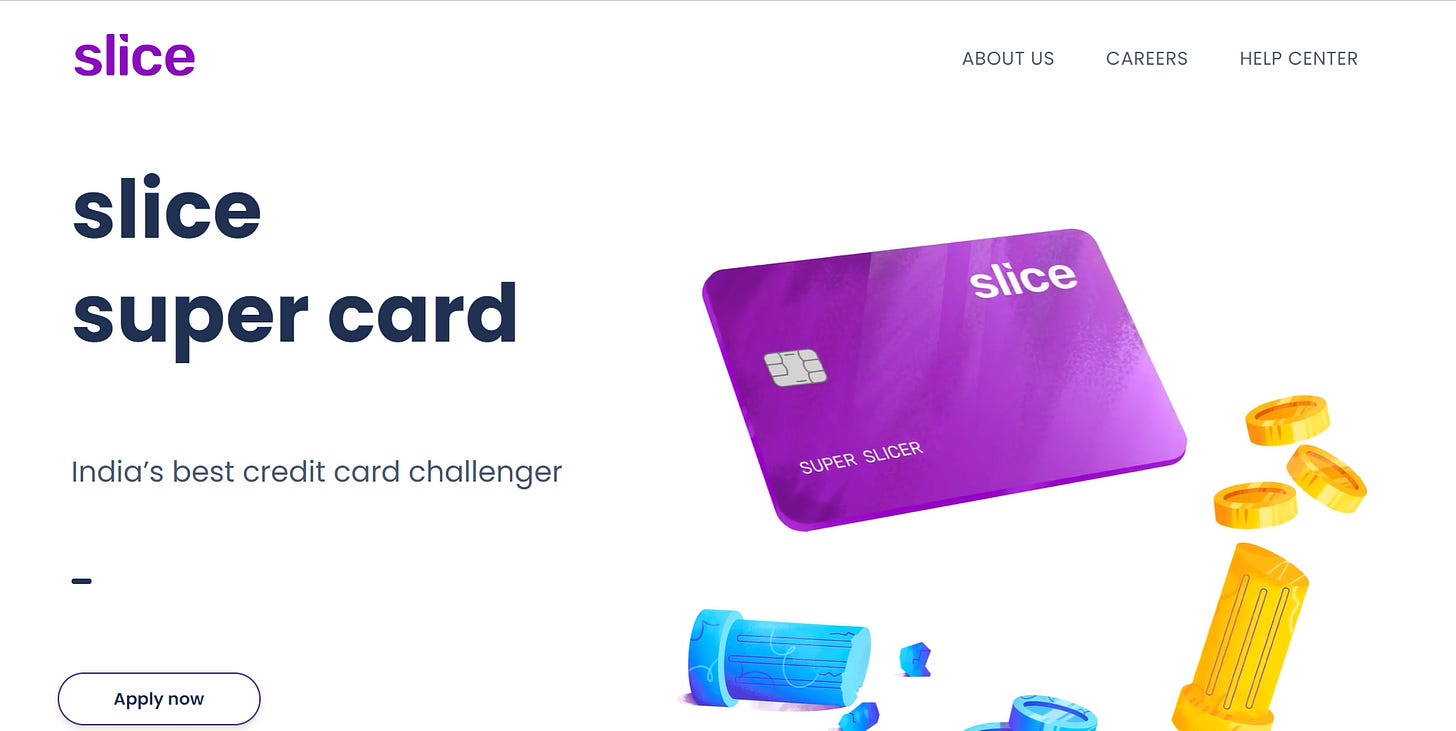Today’s newsletter is sponsored by:
Mintd is a digital wealth manager.
Sounds complex, but when I read about it, I realized these guys are solving a very important problem.
And that problem is: TOO MANY CHOICES FOR INVESTING
First, I only knew about fixed deposits. Then, I heard about stocks. Then, mutual funds. Then F&O. Then, crypto. Then, NFTs. Then, metaverse.
😴😴😴
You see the problem, right? How can noobs like me choose from this giant masala of options?
That’s why I liked Mintd’s idea so much.
Mintd uses Nobel Prize winning Modern Portfolio Theory to invest your money: diversified, low risk, high reward. You just have to sit back and watch your money grow.
Sounds good, right?
For a moment, I was convinced that Slice was a huge scam:

But then, I started researching about this startup, and holy shit I was so wrong.
The problem that Slice is solving is so important and so big that we shouldn’t even care about its misleading marketing.
I made the mistake of thinking about Slice as a credit card startup. In today’s newsletter, I’ll correct that mistake.
Today’s newsletter is a deep dive into Slice. I’ll tell you:
Story of Slice
What problem is Slice solving?
How big is this problem?
How is Slice solving this problem?
How will Slice make money by solving this problem?
Let’s go🚀🚀
🕹️Story of Slice:
College is the time when lots of us get bitten by the startup bug. Same happened with Rajan Bajaj.
He was studying civil engineering in IIT Kharagpur when he read about Airbnb and fell in love with it.
In fact, he loved Airbnb’s idea so much that he wanted to drop out in the 2nd year and do an Airbnb-like startup in India.
Ultimately, he calmed down and completed his graduation, and got a job in Flipkart’s product team.
But within 10 months, he decided he had to startup.
"If I didn’t leave and start then, probably, I would have never done it”.
He left his job in March 2015, and embarked on his first startup: Mesh.
Just like Airbnb was renting houses, Rajan decided to rent cameras, cycles, game consoles. So Mesh was like the Airbnb of cameras and consoles.
This idea didn't work. But he didn't give up.
He pivoted Mesh to: Airbnb for car and bike. Didn't work. But he didn't give up.
He pivoted Mesh to another startup idea: an Ola/Uber like model. Didn't work. He shut down Mesh. But he didn't give up.
He had heard about a finance concept in America called BNPL(buy now pay later) and wanted to try it out in India.
So in 2016, he launched Buddy, a BNPL startup. Didn’t work. But he didn't give up.
He shut down Buddy, and launched Slice Pay: a platform that gave small loans to college students. For 3 years, he struggled with Slice Pay.
Then, in 2019, he finally had the billion-dollar idea: a super credit card!
He had noticed that traditional credit cards had lots of hidden fees and high-interest rates, and customers were angry because of this shit.
So, he decided to launch a credit card that didn't have this shit.
Thus, Slice super card was born.
Bingo!
For so many years, Rajan's startups weren't working out. But this time, it was an instant hit! People loved Slice's transparent approach.
Within 5 months, Slice crossed 1 million transactions. Within 1 year, Slice got $6 million funding.
And within 2 years, on 28th November 2021, Slice became a unicorn🥳🥳
🕹️What problem is Slice solving?
The problem is: Indians don't have access to credit.
(by credit, I mean borrowing money to buy something today and paying it back later, usually with interest. There are many types of credit: bank loan, borrowing money from friends and family, credit cards, etc. So the problem that Slice is solving is: Indians don't have access to banks loans and credit cards)
I always thought that credit is bad. That's what parents and schools teach us, right? Avoid loans. Avoid credit cards. Avoid borrowing money. Otherwise, you will be caught in a debt trap.
This is correct, of course. We should take credit carefully.
But while I was researching for this article, I realized that credit is actually very important for our economy.
Here's an example: imagine a world where people don't have access to credit. So they only buy things which they can afford. In such a world, lots of people would be homeless and carless, and clothless. Sounds like stone age, right? The economy of this world would be pretty bad.
But in today's world, we can take loans from banks or borrow money from friends to buy houses and cars. The result? A vibrant economy.
That's why: Economy booms when people borrow money or take loans to buy stuff.
(it’s not as simple as this, I've grossly simplified this complex concept. But explaining this theory is beyond the scope of today's article. Its hardcore economics)
So: credit is important for our economy.
Historically, banks were responsible for giving credit to people.
But as we can see, banks failed. Just see how hard it is to get a loan or a credit card. Banks want low risks. So they give credit(loans/credit cards) only to people who have high salary jobs or high credit scores.
The result? A big part of India cannot get credit.
🕹️How big is this problem?
Very big.
Almost one billion Indians have a bank account. But banks have issued only ~60 million credit cards🤯
This means, there are 970 million people who cannot get credit.
Out of the 970 million, almost 450 million are eligible for credit cards, but don’t get one.
These 450 million people are the “financial untouchables”: People with zero credit scores, zero credit history, zero credit knowledge.
These 450 million people are Slice's target market. Pretty huge market, right?
🕹️How is Slice solving this problem:
Slice's solution to the "Indians don't have access to credit" problem is this👇
This card is the reason behind Slice's blockbuster success. Slice introduced it in 2019 to give credit to people who need it.
It’s a pay later card: people can use the card to buy stuff they need right now, and they can pay the amount later, spread over 3 months, at no interest.
Here's how it works:
I apply to Slice for a card.
Slice uses its own credit rating system built using data science algorithms to find out my creditworthiness. The algorithm uses data coming from their mobile app and checks over 50 parameters to find out the credit score.
Based on the credit score, Slice decides the card limit. It starts from Rs. 2000 and goes onto 10 lakhs.
Slice sends my details and my card limit to its partner NBFC called Quadrillion. Quadrillion makes out a loan in my name. For example, my slice card limit is 10,000. This means Quadrillion gave me a Rs. 10,000 loan.
Remember: a fintech company cannot lend money to people. Only banks and NFBCs can. That's why Slice takes the help of Quadrillion. All BNPL companies partner with an NBFC to lend money.
Only a bank has the authority to issue a card. So, Slice takes my details and my loan amount and goes to the State Bank of Mauritius, and my card is issued by SBM.
Slice gives this card to me. I immediately go to Surat Central and buy a pair of cool sneakers.
I pay for the sneakers using my Slice card. Suppose the sneakers cost 5000. This amount is deducted from my Slice card and paid immediately to Surat Central.
Now starts the difficult part: repayment.
If I immediately pay the full bill on Slice, good for them.
Slice also offers the option to split my Rs.5000 bill into 3 monthly installments with zero interest. In this case, the repayment cycle for Slice is increased. But in the end, if I pay the full amount, it’s still good for Slice.
If I don't pay the monthly installments on time, Slice will convert the Rs.5000 into a loan, with some interest. The repayment cycle is lengthened significantly.
And the extreme case: I don't pay at all. Here, Slice has 2 options: 1) do nothing 2) send goons. I hope they choose the first :)
(What's unusual about Slice is that Quadrillion is its wholly-owned subsidiary. This means Slice is using its own money to give loans to users. Other BNPL companies don't use their own money, they use the NBFC's money. idk why Slice does this. maybe higher margins?)
The result: a very elegant solution to the "Indians don't have credit" problem.
People are getting access to instant credit, but more importantly, nice repayment terms. And Slice is making nice money by lending money(how? I'll explain in the next section).
Now compare this to traditional credit cards: hidden charges, monthly fees, strict repayment terms, and high interest.
How come Slice doesn't have all this shit? Why is Slice so transparent with users?
Because Slice views its card as a payment product. Banks view credit card as a loan product.
This is why banks have so much shit attached to their credit cards. They just want to grow their loan book: through late fees and high interest rates.
Because Slice views its card as a payment product, its No.1 priority is: user retention. It wants users to use Slice every time and everywhere they pay.
To achieve this goal, it is very important that Slice earns user's trust. That's why no hidden charges or high interests.
🕹️How will Slice make money by solving this problem:
With a revenue of 35 crore from 50 lakh users, Slice is already making money by solving the credit problem.
The only question is- How.
Turns out, they have a lot of revenue sources(lots of revenue sources is common for credit cards):
Interchange: This is the biggest revenue source for Slice. Out of the 35 crore, Slice gets 24 crore from interchange. I’ll explain interchange using an example. Slice will say to Surat Central that look, you were able to sell Rs.5000 sneakers to Shreyans only because he was using Slice. Otherwise, he would have bought Rs. 2000 sneakers. So you should pay us a fee for this increased sale. This fee is called interchange.
Commissions from merchants: Slice got 5 crore revenue from commissions that merchants pay to have Slice as a payment option.
Quadrillion: This NBFC is a wholly-owned subsidiary of Slice, and brought in 6 crore revenue.
Fees from the EMI partners: Merchants like Amazon and Flipkart pay Slice for no-cost EMIs.
Income from the interests: When you exceed the 3 month payment deadline, you have to pay interest to Slice.
Late fees: if you miss the 3 month payment deadline, you have to pay late fees.
Slice has many more revenue sources lined up for the future. They want to get into UPI-credit, card for teenagers, and a digital id called "&ID".
The lending market has become very crowded. Every fintech startup wants to get into lending. Slice has so many competitors, big and small: Uni, OneCard, KreditBee, Paytm, etc.
But Slice has maintained a strong position because of 3 factors:
The algorithm for deciding card limit for each user is very good
it has many features to make sure customers keep coming back to use the app
cross-selling users with other services to monetize effectively.
This wraps up today’s newsletter. I hope you enjoyed reading it. Please share your feedback:
Or you can just reply back to this email and let me know your thoughts.
Please share this article with your friends, I’m sure they will also enjoy reading it
And if you’re new here, please subscribe- you get weekly insights on the Indian startup ecosystem:
Thanks for reading this newsletter! Bye bye and have a great day!






Pretty informative post.
Beautiful art to read and understand a company that iam going to join as an employee